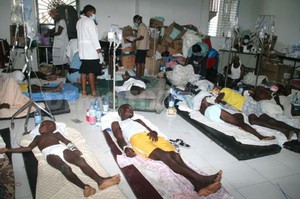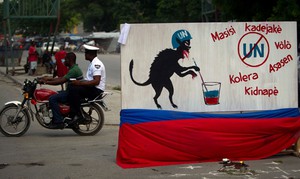Waterborne disease outbreaks caused by emergencies
A disease outbreak is the occurrence of cases of disease greater in number than would normally be expected in a defined community, geographical area or season. A waterborne disease outbreak is therefore another type of emergency situation. It might be caused by one of the natural disasters described in the last section, or due to human error, or indeed both. The greatest risk of waterborne outbreaks is pollution of water sources by faecal pathogens. This might occur due to inadequate sanitation, poor hygiene or lack of protection of water sources.
Cholera, caused by Vibrio cholerae, is a disease that is frequently associated with disasters and emergencies, where the breakdown of normal procedures and the collapse of infrastructure create conditions that lead to faecal contamination of water. This was the situation on the island of Haiti following the earthquake there in 2010.
Case Study 14.2 Cholera outbreak in Haiti
In Haiti in October 2010, ten months after a devastating earthquake, an outbreak of cholera began in an area about 100 km from the capital, Port-au-Prince. This was the first instance of cholera in Haiti for at least 100 years and by March 2011 it had killed 4672 people and thousands more were hospitalised (Figure 14.6). By March 2012, a further 2378 people had died, and more than 531,000 people had been taken ill. Furthermore, the disease spread to neighbouring countries like the Dominican Republic and Cuba.

Figure 14.6 Cholera patients undergoing treatment in Haiti.
The suspected source of the epidemic was the Artibonite River (Haiti’s longest and most important river), with which most of those who had caught the disease had been in contact. The river water was used for washing, bathing, drinking, irrigation and recreation. Along one of the tributaries of the Artibonite River was a United Nations military base for peacekeeping troops from Nepal. This came under suspicion as the source of the contamination of the river due to sewage from the base entering the river. The UN appointed a panel to investigate the source of the outbreak and they confirmed evidence that the particular strain of Vibrio cholerae isolated in the cholera cases found was similar to that circulating in South Asia, including Nepal (Cravioto et al., 2011). This suggested that the UN peacekeeping force was indeed the source and the investigation led many people to blame the UN for the cholera outbreak (Figure 14.7).

Figure 14.7 Poster in Haiti blaming the UN for the cholera outbreak that occurred in 2010.
In the years after the outbreak, medical efforts and preventive measures (such as the installation of more latrines) and changes in behaviour (for example, cooking food thoroughly and rigorously washing hands after using the toilet) brought the number of cholera cases down. The toll by November 2013 was 8448 killed and 689,448 taken ill (Pan American Health Organization, 2013).
The UN-appointed panel came up with seven recommendations in their report and two of these were related the cause of the outbreak (United Nations, 2011):
- UN personnel from countries that have cholera and who respond to emergencies in countries where cholera is not common should take antibiotics to prevent the disease before departure and/or be screened to confirm that they are not carrying Vibrio cholerae without suffering the disease.
- UN installations worldwide should treat faecal waste using on-site systems to inactivate pathogens before disposal. These systems should be operated and maintained by trained, qualified UN staff or by local providers with adequate UN oversight.